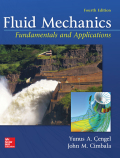
Concept explainers
Repeat Prob. 6-66 by taking into consideration the weight of the elbow v1ose mass is 5 kg.
290
The force acting on the flanges of the elbow.
The force line of action angle with horizontal.
Answer to Problem 67P
The force acting on the flanges of the elbow is
The force line of action angle with horizontal is
Explanation of Solution
Given information:
The volume flow rate is
Write the expression for velocity.
Here, volume flow rate is
Consider inlet point as
Write the expression for Bernoulli equation.
Here, density is
Write the expression for force in x-direction.
Write the expression for force in y-direction.
Write the expression for weight of water contained in the elbow.
Here density of water is
Write the expression for resultant of force on elbow.
Here, resultant force in x-direction is
Write the expression for angle of line of action of resultant force with horizontal.
Here, resultant force in x-direction is
Calculation:
Substitute
Substitute
Refer to table "properties of saturated water" to obtain the density of water as
Substitute
Substitute,
Substitute
Substitute,
Substitute
Substitute
Here, angle of resultant force depends on force component sign.
Here, angle is measured from horizontal in anti-clockwise direction.
Conclusion:
The force acting on the flanges of the elbow is
The force line of action angle with horizontal is
Want to see more full solutions like this?
Chapter 6 Solutions
Fluid Mechanics: Fundamentals and Applications
- Sketch and describe hatch coamings. Describe structrual requirements to deck plating to compensate discontinuity for corners of a hatch. Show what is done to the deck plating when the decks are cut away and include the supporting members.arrow_forwardAn Inclining experiment done on a ship thats 6500 t, a mass of 30t was moved 6.0 m transvesly causing a 30 cm deflection in a 6m pendulum, calculate the transverse meta centre height.arrow_forwarda ship 150 m long and 20.5 m beam floats at a draught of8 m and displaces 19 500 tonne. The TPC is 26.5 and midshipsection area coefficient 0.94. Calculate the block, prismatic andwaterplane area coefficients.arrow_forward
- A vessel loads 680 t fuel between forward and aft deep tanks. centre of gravity of forward tank is 24m forward of ships COG. centre to centre between tanks is 42 m. how much in each tank to keep trim the samearrow_forwardBeam of a vessel is 11% its length. Cw =0.72. When floating in SW of relative denisity 1.03, TPC is 0.35t greater than in freshwater. Find the length of the shiparrow_forwardAn inclining experiment was carried out on a ship of 4000tonne displacement, when masses of 6 tonne were moved transverselythrough 13.5 m. The deflections of a 7.5 m pendulurnwere 81, 78, 85, 83, 79, 82, 84 and 80 mm respectively.Caiculate the metacentric height.arrow_forward
- A ship of 10 000 tonne displacement has a waterplanearea of 1300 m2. The ship loads in water of 1.010 t/m3 andmoves into water of 1.026 t/m3. Find the change in meandraughtarrow_forwardA ship of 7000 tonne displacement has a waterplane areaof 1500 m2. In passing from sea water into river water of1005 kg/m3 there is an increase in draught of 10 cm. Find the Idensity of the sea water.arrow_forwardA ship has 300 tonne of cargo in the hold, 24 m forward ofmidships. The displacement of the vessel is 6000 tonne and its centre of gravity is 1.2 m forward of midships.Find the new position of the centre of gravity if this cargo ismoved to an after hold, 40 m from midshipsarrow_forward
- Sketch and describe how ships are supported in dry dock. When and where does the greatest amount of stresses occur?arrow_forwardSketch and desribe a balanced rudder and how it is suspendedarrow_forwardA ship 140 m long and 18 m beam floats at a draught of9 m. The immersed cross-sectionai areas at equai intervais are 5,60, 116, 145, 152, 153, 153, 151, 142, 85 and 0 m2 respectively.Calculate:(a) displacement(b) block coefficient(c) midship section area coefficient(d) prismatic coefficient.arrow_forward
 International Edition---engineering Mechanics: St...Mechanical EngineeringISBN:9781305501607Author:Andrew Pytel And Jaan KiusalaasPublisher:CENGAGE L
International Edition---engineering Mechanics: St...Mechanical EngineeringISBN:9781305501607Author:Andrew Pytel And Jaan KiusalaasPublisher:CENGAGE L
